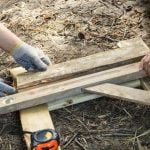Wood selection is a critical aspect of woodworking, as it directly impacts the quality and success of a project. Whether you are a seasoned woodworker or just starting out, understanding the characteristics and properties of different woods is essential. In this article, we will focus on one particular wood species – live oak – and explore its suitability for woodworking projects.
Live oak, known for its strength and durability, has been utilized in various applications throughout history. From shipbuilding to furniture making, this hardwood has proven its worth in many industries. But what makes live oak a good choice for woodworking?
To answer that question, it is important to delve into the characteristics and properties of live oak. Its dense grain structure provides exceptional strength, making it ideal for structural elements such as beams and posts. Additionally, live oak possesses inherent resistance to decay and insect damage due to high levels of tannin content. These qualities make it suitable for outdoor projects such as garden furniture or decking.
Furthermore, the stability of live oak contributes to its usability in woodworking. It exhibits low shrinkage and minimal warping or twisting over time, which ensures the longevity of finished pieces. This stability also allows for ease in machining and finishing processes, thereby enhancing efficiency during construction.
In the following sections of this article, we will explore live oak’s characteristics further, including its availability and cost in lumber form, workability aspects such as machining and finishing techniques, ideal woodworking applications for this wood species, expert tips and techniques when working with it, as well as compare it to other commonly used woods.
By the end of this comprehensive guide on live oak in woodworking, you will have a solid understanding of whether it is a suitable choice for your next project.
What is Live Oak
Live Oak is a type of oak tree (scientifically known as Quercus virginiana) that is native to the southeastern United States. It is a popular choice among woodworkers due to its unique characteristics and properties.
- Characteristics: Live Oak is known for its dense and heavy nature, making it incredibly strong and durable. The wood has a distinct coarse texture, with straight to wavy grains. It typically has a golden-brown color and can display beautiful figuring, including knots and other natural features that add character to woodworking projects.
- Properties: One of the standout properties of Live Oak is its exceptional strength. It has a high crushing strength and bending strength, making it highly resistant to impact and wear. Additionally, Live Oak is known for its natural resistance to decay and insect infestation, which adds to its durability.
The density of Live Oak also makes it highly stable and resistant to warping or shrinking, even in humid environments. This stability makes it an excellent choice for outdoor furniture or structures that are exposed to the elements. Its density also makes it great for applications where sturdiness is required, such as beams or flooring.
In summary, Live Oak’s characteristics make it an excellent choice for woodworking projects that require strength, durability, stability, and resistance to decay. Its unique appearance adds aesthetic value to projects while its natural properties ensure longevity. Whether you’re building furniture, cabinetry, or outdoor structures, Live Oak can be a reliable and beautiful option for your woodworking needs.
Live Oak in Woodworking
Strength
Live Oak is known for its exceptional strength, making it a popular choice among woodworkers. The dense and heavy nature of Live Oak gives it a high level of structural integrity.
It has a Janka hardness rating of 2,680 pounds-force (lbf), which is significantly higher than other commonly used hardwoods like Red Oak (1,290 lbf) and Hard Maple (1,450 lbf). This means that Live Oak is highly resistant to dents and wear, making it ideal for furniture and flooring applications that require durability.
Durability
One of the key advantages of using Live Oak in woodworking is its natural durability. Live Oak possesses excellent resistance to decay and insect infestations due to the high levels of tannins present in the wood. Tannins are chemicals that naturally protect the tree from fungi and insects. As a result, projects made with Live Oak are able to withstand environmental factors such as humidity, moisture, and temperature changes without significant damage or deterioration.
Stability
Another important characteristic of Live Oak in woodworking is its stability. This refers to how well the wood resists warping, shrinking, or expanding when exposed to varying levels of moisture. Due to its density and low moisture content, Live Oak exhibits minimal movement when compared to other wood species. This makes it an excellent choice for projects that require dimensional stability over time, such as outdoor furniture or cabinetry in areas with high humidity.
Overall, Live Oak offers exceptional strength, durability, and stability for woodworking projects. Its density and structural integrity make it suitable for applications where longevity is desired. Additionally, its resistance to decay and insects ensures that projects made with Live Oak will last even in challenging environmental conditions.
Live Oak Lumber
When considering using live oak lumber for woodworking projects, it is important to understand its availability and cost. Availability refers to how easy or difficult it is to find live oak lumber in the market, while cost pertains to the price of acquiring this type of wood. In this section, we will explore these factors in more depth.
Availability
Live oak trees are primarily found in the southeastern United States, particularly in states like Texas, Florida, and Georgia. The abundance of live oak forests in these regions makes it relatively easier to find local suppliers who offer live oak lumber. However, it may still require some effort to locate specialized suppliers or mills that specifically deal with live oak.
It is worth noting that live oak as a hardwood species tends to be less widely available compared to other types of wood commonly used in woodworking. Due to its slower growth rate and specific habitats required for its growth, finding a consistent supply of live oak lumber can prove challenging.
Cost
The cost of live oak lumber can be higher than that of other wood species commonly used in woodworking. The combination of limited availability and high demand for this hardwood contributes to its comparatively higher price point.
Additionally, the quality and condition of the live oak lumber can also impact its cost. Lumber that is kiln-dried and well-prepared for woodworking projects tends to command a higher price due to the additional labor and expertise involved in its processing.
Although the expense associated with obtaining live oak lumber may deter some woodworkers, it is important to consider the unique characteristics and benefits that this wood species offers before making a decision solely based on cost.
Live Oak Workability
Live Oak, known for its strength and durability, is a popular choice among woodworkers due to its workability. It is important to assess the ease of machining and finishing when considering Live Oak for woodworking projects.
In terms of machining, Live Oak can be relatively challenging to work with compared to some other wood species. Its high density and hardness can make it difficult to cut, shape, and carve. However, with the right tools and techniques, it is still possible to achieve desired results.
It is recommended to use sharp cutting tools and take light passes when working with Live Oak. Additionally, using carbide-tipped blades or router bits can help in reducing tear-out and achieving clean cuts.
When it comes to finishing, Live Oak takes finishes exceptionally well. Its closed cell structure makes it resistant to moisture penetration, allowing for a flawless finish application. The wood’s beautiful grain pattern and color variation also contribute to its natural beauty when finished. Whether you choose to apply oil-based finishes or water-based options like polyurethane or lacquer, Live Oak will bring out its rich tones and highlight its unique characteristics.
It is worth noting that despite its workability challenges during machining, many woodworkers consider Live Oak a worthwhile investment due to the stunning end results that can be achieved. With patience, skill, and attention to detail, Live Oak can be transformed into remarkable furniture pieces, flooring, cabinetry, and more.
Projects Perfect for Live Oak
Live Oak is a highly versatile wood that can be used in a variety of woodworking projects. Its distinct characteristics and properties make it perfect for certain applications where durability and strength are necessary.
One ideal application for Live Oak is in the construction of outdoor furniture. Due to its high density and natural resistance to rot and decay, Live Oak is well-suited for withstanding the elements, making it an excellent choice for garden benches, patio tables, and other pieces that will be exposed to moisture and sunlight.
In addition, Live Oak’s unique grain patterns and rich color make it a popular choice for decorative woodworking projects such as cabinets, shelves, and display cases. This wood has a warm and inviting appearance that adds character to any room or space.
Furthermore, Live Oak is often used in boat building and marine applications. The wood’s natural resistance to water makes it an excellent choice for constructing boat decks, hull planks, and other components that are constantly exposed to moisture.
When working with Live Oak, it is important to keep in mind its hardness and stiffness. This can make machining more challenging compared to softer woods. However, with the right tools and techniques, this wood can be shaped into beautiful pieces that will last for generations.
| Applications | Description |
|---|---|
| Outdoor Furniture | Live Oak’s durability and resistance to rot make it perfect for garden benches and patio tables. |
| Decorative Woodworking | The unique grain patterns and rich color of Live Oak add character to cabinets, shelves, and display cases. |
| Boat Building | The wood’s natural resistance to water makes it ideal for boat decks and hull planks. |
Expert Tips and Techniques for Working with Live Oak
Working with Live Oak requires some specific techniques and skills due to its unique characteristics. Here are some expert tips to help you navigate the challenges of working with this beautiful wood:
- Proper Handling: Live Oak is known for its density and weight, so it is important to handle the wood carefully to prevent strain or injury. Use proper lifting techniques and consider enlisting the help of a partner when working with larger pieces.
- Preparing the Wood: Due to its high moisture content, Live Oak needs to be properly seasoned before use in woodworking projects. This involves drying the wood slowly and evenly in controlled conditions to prevent cracking or warping. It is recommended to air dry Live Oak lumber for at least two years before using it.
- Tool Selection: When working with Live Oak, it is essential to use sharp tools that can withstand the density of the wood. Dull tools will make cutting and shaping difficult, so be sure to sharpen your blades regularly.
- Fastening Techniques: The dense nature of Live Oak makes it resistant to nails and screws, so traditional fastening methods may not be effective. Consider using dowels or specialized joinery techniques such as mortise-and-tenon joints for a stronger bond.
- Finishing: Live Oak has a beautiful natural grain pattern that can be enhanced through proper finishing techniques. Before applying any finishes, ensure that the surface is clean and smooth by sanding it thoroughly. Consider using oil-based finishes or varnishes that penetrate deeper into the wood for better protection.
- Safety Precautions: Working with any type of wood involves risks, so always prioritize safety measures when handling Live Oak. Wear proper protective equipment such as goggles, gloves, and a dust mask when cutting, sanding, or finishing this hardwood.
| Aspect | Information |
|---|---|
| Wood Density | Dense and heavy (approximately 64 lbs/ft³) |
| Moisture Content for Drying | Air dry for at least two years |
| Recommended Tools and Techniques | Sharp cutting tools, specialized joinery techniques, oil-based finishes or varnishes |
| Safety Precautions | Wear goggles, gloves, and a dust mask; practice proper lifting techniques to avoid strain or injury |
By following these expert tips and techniques, you can make the most of Live Oak’s unique qualities in your woodworking projects. Remember to always exercise patience and caution when working with this hardwood to achieve the best results.
Comparing Live Oak with Other Wood Species for Woodworking
When it comes to woodworking, the selection of wood species is crucial in determining the outcome of a project. Each wood species possesses unique characteristics and properties that can greatly affect the strength, durability, and overall appearance of the finished product. In this section, we will compare Live Oak with other commonly used wood species to understand its advantages and disadvantages in woodworking.
One popular wood species often compared to Live Oak is White Oak. While both share similarities in terms of strength and density, Live Oak is known for its higher level of rot resistance. This makes it an excellent choice for outdoor furniture or structures that are exposed to harsh weather conditions. On the other hand, White Oak offers more flexibility, making it easier to work with in intricate woodworking projects.
Another common comparison is between Live Oak and Walnut. Walnut is revered for its dark brown color, which adds elegance and sophistication to any woodworking project. However, compared to Live Oak, Walnut tends to be softer and may not withstand heavy wear as well. Additionally, Live Oak has a coarse texture that gives it a distinct character when incorporated into furniture or cabinetry.
When considering cost-efficiency, Pine is often pitted against Live Oak. Pine is widely available and relatively inexpensive compared to Live Oak lumber. However, Live Oak’s superior durability and longevity make it a worthwhile investment for projects that require long-term use or exposure to moisture.
Wood Species Comparison
- Live Oak: Higher rot resistance; coarse texture
- White Oak: Flexibility; suitable for intricate projects
- Walnut: Dark brown color; adds elegance
- Pine: Affordable; suitable for projects with exposure to moisture
Conclusion
Live Oak, with its impressive characteristics and properties, can certainly be a good choice for woodworking projects. Throughout this article, we have gained a deeper understanding of the importance of wood selection in woodworking and specifically examined Live Oak’s strength, durability, stability, availability, cost, workability, and ideal applications.
When it comes to strength, Live Oak is known for its exceptional resistance to impact and wear. Its dense grain structure ensures that it can withstand heavy loads and resist bending or warping over time. In terms of durability, Live Oak boasts excellent resistance to decay and rot. This makes it an ideal choice for outdoor furniture or structures that will be exposed to the elements.
One factor that contributes to Live Oak’s popularity among woodworkers is its availability and cost. While it may not be as commonly found as some other wood species, Live Oak can still be sourced from reputable lumber yards or specialty suppliers. Additionally, although it may be slightly more expensive than some other woods due to its desirable characteristics, the unique beauty and longevity make it a worthwhile investment.
Another important consideration when selecting wood for your woodworking projects is workability. Live Oak is generally considered to be moderately difficult to work with due to its dense nature and interlocked grain pattern. However, with the right tools and techniques at your disposal, such as sharp blades and proper sanding methods, you can achieve stunning results.
In conclusion, if you are seeking a wood that combines strength, durability, unique beauty, and moderate workability for your woodworking projects – then Live Oak could indeed be the perfect choice for you. With proper knowledge of how to handle this distinctive material through expert tips and techniques gained from experienced woodworkers who have worked with Live Oak before, you can confidently embark on any project knowing that you have chosen a versatile wood that will stand the test of time.
So give Live Oak a try in your next woodworking creation – you won’t be disappointed.
Frequently Asked Questions
Is live oak wood good for anything?
Live oak wood is highly regarded for its strength, durability, and beauty, making it valuable for various purposes. Its dense grain and resistance to decay make it an excellent choice for outdoor projects like decking, fencing, and boatbuilding.
The wood’s natural acidity also makes it resistant to insect infestations and fungal diseases, further enhancing its utility. Additionally, live oak wood can be utilized in the creation of handcrafted items such as bowls, walking sticks, and decorative carvings due to its attractive grain patterns.
Can live oak trees be used for lumber?
Absolutely! Live oak trees have long been recognized for their suitability as a source of lumber. The dense heartwood found in mature live oaks possesses remarkable strength properties that enable it to withstand significant pressure and stress.
As a result, live oak lumber is often used in construction projects that necessitate high load-bearing capabilities. Furthermore, its beautiful appearance enhances its desirability for interior applications like flooring, cabinetry, paneling, and millwork. Though availability may vary regionally due to environmental factors and conservation efforts necessitated by the tree’s slow growth rate.
Can you make furniture with live oak?
Live oak wood lends itself exceptionally well to furniture making due to its aesthetic qualities and robust nature. Its distinctive grain patterns ranging from straight lines to irregular swirls create visually stunning pieces that showcase the natural beauty of the wood.
Combined with live oak’s resilience and durability, furniture crafted from this material can withstand years of use while retaining its charm. From dining tables and chairs to cabinets or even intricate carvings on headboards or drawer fronts, live oak can serve as a versatile medium for creating both functional and ornamental furniture pieces that exhibit timeless elegance.

Hi everyone! I’m a woodworker and blogger, and this is my woodworking blog. In my blog, I share tips and tricks for woodworkers of all skill levels, as well as project ideas that you can try yourself.





